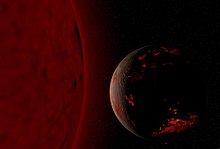4千年紀以降
表示
(6千年紀から転送)
| 千年紀: | 3千年紀 - 4千年紀以降 |
|---|
4千年紀以降(4せんねんきいこう)は、西暦による4番目以降の千年紀(ミレニアム)で、3001年(31世紀)以降に当たる。
予測
[編集]- 3310年 - 日本の人口が22人になる[1]。
- タイムカプセル開封:6939年(ニューヨーク、1939年封)[2]、6970年(大阪、1970年封)[3]、8113年(ジョージア州、1936年封)[4]。
- 9361年、9622年、9966年、10663年、11268年、11575年、15790年に日食と水星の太陽面通過、15232年に日食と金星の太陽面通過、69163年に水星と金星の太陽面通過が同時発生[5]。
- 1万年にデネブ、15500年にベガ、22000年にトゥバン、28000年にポラリスが北極星に[6]。
- 12000年:南極ウィルクス盆地の氷塊が数百年で脱落、海面が3m上昇[7]。
- ボイジャー1号は4万年にグリーゼ445、ボイジャー2号は29.6万年にシリウス、パイオニア10号は200万年にアルデバランに接近[8]。
- 38000年:ロス248が太陽から3光年に接近[9]。
- 5万年:ナイアガラの滝がエリー湖に吸収[10]。
- 10万年:おおいぬ座VY星の極超新星爆発[11]。
- 30万年:WR 104のガンマ線バースト[12]。
- 50万年:バッドランズ国立公園が完全に侵食[13]。
- 100万年:ベテルギウスの超新星爆発[14]。天王星の衛星デズデモーナとクレシダ(10億年後キューピッドとベリンダも)が衝突[15]。静かの基地が侵食[16]。
- 140万年:グリーゼ710が太陽から0.2光年に接近、オールトの雲に作用し彗星が増加[17]。
- 270万年:ケンタウロス族の半数が軌道を外れる[18]。
- 800万年:LAGEOSの大気圏再突入[19]。
- 1000万年:大地溝帯でアフリカが分裂[20]。
- 5000万年:フォボスが火星に衝突[21]。サンアンドレアス断層がアリューシャン海溝に沈む[22]。地中海が消滅、ヒマラヤ級の山脈に[23]。
- 1億年:土星の環が崩壊[24]。
- 2億年:超大陸形成[25]。
- 8億年:太陽光度増大で二酸化炭素が減少し光合成が止まり、2億年で海が蒸発、更に18億年で全生物絶滅[26]。
- 10億年:ボイジャーのゴールデンレコードの寿命[27]。
- 23億年:太陽風が地磁気の保護を失った大気を剥がし出す[28][29]。
- 30億年:月が離れ、地球の赤道傾斜角が不安定化[30]。
- 36億年:トリトンが海王星の潮汐力で環となる[31]。
- 40億年:銀河系とアンドロメダ銀河の衝突[32]。
- 75億年:太陽膨張で地球と火星が潮汐固定[33]。

- 76億年:太陽が赤色巨星化し地球を吸収、4億年で白色矮星化[34]。
- 500億年:地球と月がある場合、両者が潮汐固定[35]。
- 1000億年:宇宙膨張で局所銀河群外が観測不能に[36]。
- 4500億年:局所銀河群の銀河が統一[37]。
- 8000億年:初の青色矮星出現[38]。
- 120兆年:星間ガスを使い切り全恒星が寿命を迎え、1020年内に大半の褐色矮星とコンパクト星が銀河から弾き出される[37]。
- 2×1036年:陽子半減期が8.2×1033年なら、観測可能な宇宙の全陽子が崩壊[37]。
- 1.7×10106年:最大のブラックホールが蒸発[39]。
- 101500年:陽子崩壊がなければ鉄の星出現、年後トンネル効果でブラックホール化[40]。
注
[編集]- ^ “夫婦同姓が続くと…2531年には「全員が佐藤さん」 東北大試算”. 毎日新聞. 2024年4月3日閲覧。
- ^ Westinghouse Time Capsule: 80 years on, still 4920 years to go... (2023年11月12日閲覧)
- ^ タイム・カプセルEXPO'70 - パナソニック
- ^ CRYPT OF CIVILIZATION TIME CAPSULE (2023年11月12日閲覧)
- ^ J.Meeus; A.Vitagliano (2004). “Simultaneous Transits”. Journal of the British Astronomical Association 114 (3) 2023年11月17日閲覧。.
- ^ “Future North Poles”. Texas University. 2023年11月17日閲覧。
- ^ Mengel, M.; A. Levermann (4 May 2014). “Ice plug prevents irreversible discharge from East Antarctica”. Nature Climate Change 4 (6): 451–455. Bibcode: 2014NatCC...4..451M. doi:10.1038/nclimate2226.
- ^ “Plotting the Destinations of 4 Interstellar Probes”. IEEE. 2023年11月18日閲覧。
- ^ Matthews, R. A. J. (Spring 1994). “The Close Approach of Stars in the Solar Neighborhood”. Quarterly Journal of the Royal Astronomical Society 35 (1): 1. Bibcode: 1994QJRAS..35....1M.
- ^ Niagara Parks. “Facts about Niagara Falls”. 2023年11月18日閲覧。
- ^ Monnier, J. D.; al., et. “The Last Gasps of VY Canis Majoris: Aperture Synthesis and Adaptive Optics Imagery”. The Astrophysical Journal 512 (1): 351–361. arXiv:astro-ph/9810024. Bibcode: 1999ApJ...512..351M. doi:10.1086/306761.
- ^ Tuthill, Peter; Monnier, John; Lawrance, Nicholas; Danchi, William; Owocki, Stan; Gayley, Kenneth (2008). “The Prototype Colliding-Wind Pinwheel WR 104”. The Astrophysical Journal 675 (1): 698–710. arXiv:0712.2111. Bibcode: 2008ApJ...675..698T. doi:10.1086/527286.
- ^ Geologic Formations: How Badlands Buttes Came to Be".
- ^ “Sharpest Views of Betelgeuse Reveal How Supergiant Stars Lose Mass”. Press Releases. European Southern Observatory (29 July 2009). 2023年11月17日閲覧。
- ^ “Uranus's colliding moons”. astronomy.com (2017年). 2017年9月23日閲覧。
- ^ "Apollo 11 -- First Footprint on the Moon". Student Features. NASA.
- ^ Filip Berski, Piotr A. Dybczyński (25 October 2016). “Gliese 710 will pass the Sun even closer”. Astronomy and Astrophysics 595 (L10). Bibcode: 2016A&A...595L..10B.
- ^ J.Horner; N.W.Evans, N.W.; M. E.Bailey (2004). “Simulations of the Population of Centaurs I: The Bulk Statistics”. Monthly Notices of the Royal Astronomical Society 354 (3): 798–810. arXiv:astro-ph/0407400. Bibcode: 2004MNRAS.354..798H. doi:10.1111/j.1365-2966.2004.08240.x.
- ^ “LAGEOS 1, 2”. NASA. 2023年11月17日閲覧。
- ^ Haddok, Eitan (29 September 2008). “Birth of an Ocean: The Evolution of Ethiopia's Afar Depression”. Scientific American. 2023年11月17日閲覧。
- ^ Bills, Bruce G.; Gregory A. Neumann; David E. Smith; Maria T. Zuber (2005). “Improved estimate of tidal dissipation within Mars from MOLA observations of the shadow of Phobos”. Journal of Geophysical Research 110 (E07004). Bibcode: 2005JGRE..110.7004B. doi:10.1029/2004je002376.
- ^ Garrison, Tom (2009). Essentials of Oceanography (5 ed.). Brooks/Cole. p. 62
- ^ “Continents in Collision: Pangea Ultima”. NASA (2000年). 2023年11月17日閲覧。
- ^ Lang, Kenneth R. (2003). The Cambridge Guide to the Solar System. Cambridge University Press. pp. 328–329
- ^ Williams, Caroline; Nield, Ted (20 October 2007). “Pangaea, the comeback”. New Scientist. オリジナルの13 April 2008時点におけるアーカイブ。 2023年11月17日閲覧。
- ^ O'Malley-James, Jack T.; Greaves, Jane S.; Raven, John A.; Cockell, Charles S. (2012). “Swansong Biospheres: Refuges for life and novel microbial biospheres on terrestrial planets near the end of their habitable lifetimes”. International Journal of Astrobiology 12 (2): 99–112. arXiv:1210.5721. Bibcode: 2013IJAsB..12...99O. doi:10.1017/S147355041200047X.
- ^ Jad Abumrad, Robert Krulwich (2010年2月12日). “Carl Sagan And Ann Druyan's Ultimate Mix Tape”. National Public Radio. 2024年1月12日閲覧。
- ^ McDonough, W. F. (2004). “Compositional Model for the Earth's Core”. Treatise on Geochemistry 2: 547–568. Bibcode: 2003TrGeo...2..547M. doi:10.1016/B0-08-043751-6/02015-6. ISBN 978-0-08-043751-4.
- ^ Quirin Shlermeler (3 March 2005). “Solar wind hammers the ozone layer”. News@nature. doi:10.1038/news050228-12.
- ^ Neron de Surgey, O.; Laskar, J. (1996). “On the Long Term Evolution of the Spin of the Earth”. Astronomy and Astrophysics 318: 975. Bibcode: 1997A&A...318..975N.
- ^ Chyba, C. F.; Jankowski, D. G.; Nicholson, P. D. (1989). “Tidal Evolution in the Neptune-Triton System”. Astronomy and Astrophysics 219: 23. Bibcode: 1989A&A...219L..23C.
- ^ Cox, J. T.; Loeb, Abraham (2007). “The Collision Between The Milky Way And Andromeda”. Monthly Notices of the Royal Astronomical Society 386 (1): 461–474. arXiv:0705.1170. Bibcode: 2008MNRAS.tmp..333C. doi:10.1111/j.1365-2966.2008.13048.x.
- ^ Kargel, Jeffrey Stuart (2004). Mars: A Warmer, Wetter Planet. Springer. p. 509. ISBN 978-1-85233-568-7 2023年11月17日閲覧。
- ^ Schroder, K. P.; Connon Smith, Robert (2008). “Distant Future of the Sun and Earth Revisited”. Monthly Notices of the Royal Astronomical Society 386 (1): 155–163. arXiv:0801.4031. Bibcode: 2008MNRAS.386..155S. doi:10.1111/j.1365-2966.2008.13022.x.
- ^ Murray, C.D.; Dermott, S.F. (1999). Solar System Dynamics. Cambridge University Press. p. 184. ISBN 978-0-521-57295-8
- ^ Loeb, Abraham (2011). “Cosmology with Hypervelocity Stars”. Harvard University 2011: 023. arXiv:1102.0007. Bibcode: 2011JCAP...04..023L. doi:10.1088/1475-7516/2011/04/023.
- ^ a b c Adams, Fred C.; Laughlin, Gregory (April 1997). “A dying universe: the long-term fate and evolution of astrophysical objects”. Reviews of Modern Physics 69 (2): 337-372. arXiv:astro-ph/9701131. Bibcode: 1997RvMP...69..337A. doi:10.1103/RevModPhys.69.337.
- ^ Adams, F. C.; Graves, G. J. M.; Laughlin, G. (December 2004). García-Segura, G.; Tenorio-Tagle, G.; Franco, J. et al.. eds. “Red Dwarfs and the End of the Main Sequence”. Revista Mexicana de Astronomía y Astrofísica (Serie de Conferencias) 22: 46–49. Bibcode: 2004RMxAC..22...46A.
- ^ Page, Don N. (1976). “Particle Emission Rates from a Black Hole: Massless Particles from an Uncharged, Nonrotating Hole”. Physical Review D 13 (2): 198-206. Bibcode: 1976PhRvD..13..198P. doi:10.1103/PhysRevD.13.198.
- ^ Dyson, Freeman J. (1979). “Time Without End: Physics and Biology in an Open Universe”. Reviews of Modern Physics 51 (3): 447–460. Bibcode: 1979RvMP...51..447D. doi:10.1103/RevModPhys.51.447 2023年11月18日閲覧。.

